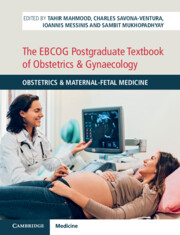Book contents
- The EBCOG Postgraduate Textbook of Obstetrics & Gynaecology
- The EBCOG Postgraduate Textbook of Obstetrics & Gynaecology
- Copyright page
- Dedication
- Contents
- Contributors
- Preface
- Section 1 Basic Sciences in Obstetrics
- Section 2 Early Pregnancy Problems
- Section 3 Fetal Medicine
- Chapter 10 Pre-Conception Care
- Chapter 11 Ultrasound Scanning in the First Trimester of Pregnancy
- Chapter 12 Prenatal Diagnostic Techniques
- Chapter 13 Invasive Fetal Therapies
- Chapter 14 Normal Fetal Growth and Fetal Macrosomia
- Chapter 15 Fetal Haemolysis
- Chapter 16 Antenatal Care of a Normal Pregnancy
- Chapter 17 Screening for High-Risk Pregnancy
- Chapter 18 Multiple Pregnancy
- Chapter 19 Intrauterine Growth Restriction
- Chapter 20 Fetal Origin of Adult Disease
- Chapter 21 Antepartum Haemorrhage
- Chapter 22 Obstetric Care of Migrant Populations
- Chapter 23 Care of Women with Previous Adverse Pregnancy Outcome
- Chapter 24 Preterm Prelabour Rupture of Membranes
- Section 4 Maternal Medicine
- Section 5 Intrapartum Care
- Section 6 Neonatal Problems
- Section 7 Placenta
- Section 8 Public Health Issues in Obstetrics
- Section 9 Co-Morbidities during Pregnancy
- Index
- Plate Section (PDF Only)
- References
Chapter 22 - Obstetric Care of Migrant Populations
from Section 3 - Fetal Medicine
Published online by Cambridge University Press: 20 November 2021
- The EBCOG Postgraduate Textbook of Obstetrics & Gynaecology
- The EBCOG Postgraduate Textbook of Obstetrics & Gynaecology
- Copyright page
- Dedication
- Contents
- Contributors
- Preface
- Section 1 Basic Sciences in Obstetrics
- Section 2 Early Pregnancy Problems
- Section 3 Fetal Medicine
- Chapter 10 Pre-Conception Care
- Chapter 11 Ultrasound Scanning in the First Trimester of Pregnancy
- Chapter 12 Prenatal Diagnostic Techniques
- Chapter 13 Invasive Fetal Therapies
- Chapter 14 Normal Fetal Growth and Fetal Macrosomia
- Chapter 15 Fetal Haemolysis
- Chapter 16 Antenatal Care of a Normal Pregnancy
- Chapter 17 Screening for High-Risk Pregnancy
- Chapter 18 Multiple Pregnancy
- Chapter 19 Intrauterine Growth Restriction
- Chapter 20 Fetal Origin of Adult Disease
- Chapter 21 Antepartum Haemorrhage
- Chapter 22 Obstetric Care of Migrant Populations
- Chapter 23 Care of Women with Previous Adverse Pregnancy Outcome
- Chapter 24 Preterm Prelabour Rupture of Membranes
- Section 4 Maternal Medicine
- Section 5 Intrapartum Care
- Section 6 Neonatal Problems
- Section 7 Placenta
- Section 8 Public Health Issues in Obstetrics
- Section 9 Co-Morbidities during Pregnancy
- Index
- Plate Section (PDF Only)
- References
Summary
Migration is defined as movement into a country with the intent to settle; refugees are a subgroup of people who are unable or unwilling to return to their country of origin because of persecution or a well-founded fear of persecution due to their race, religion, nationality, membership of a particular social group or political opinion, and who have been granted refugee status by the host country. Each year, millions of women flee their homelands to escape local crises across the globe. War, genocide, persecution and natural disasters may be the major causes of migration, often without the option of returning back home. It is estimated that about 44 000 people are forcibly made to migrate every day [1]. Populations in developed countries comprise a considerable and growing proportion of migrants and descendants of migrants with a great proportion of births from foreign-born women. To date, European data on the health of migrants and their descendants are incomplete and show contradictory results.
- Type
- Chapter
- Information
- The EBCOG Postgraduate Textbook of Obstetrics & GynaecologyObstetrics & Maternal-Fetal Medicine, pp. 183 - 189Publisher: Cambridge University PressPrint publication year: 2021

